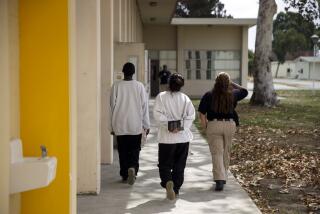Teen Shelter Approved, Despite Strong Protest
- Share via
The San Diego City Council voted Monday to uphold a plan to start up a shelter for homeless teen-agers despite opposition from downtown residents who said their Marina district neighborhood is an inappropriate location for such a facility.
After a heated and occasionally tearful debate, council members approved Father Joe Carroll’s plan to set up Teen Quest, a shelter for 15 boys and 15 girls.
“This is a lose-lose situation. . . . The fact is that these are homeless teen-agers, and many of them have problems,” said Pam Hamilton, executive director of the Centre City Development Corp., who warned that the facility would discourage customers and residents. “This is a delicate area.”
In a move that clearly enraged Mayor Maureen O’Connor, Hamilton handed council members photographs of food lines of homeless people being fed by staff members at the St. Vincent de Paul/Joan Kroc Center, the same group that will run the shelter.
O’Connor repeatedly blasted Hamilton for showing the photographs, saying the two represented very different types of programs that would be run by the well-regarded St. Vincent de Paul shelter. “To fan the fear and bring these photographs is very unfortunate,” O’Connor scolded.
Teen Quest will be situated across the street from Columbia Place, an award-winning, 103-unit condominium project that was recognized for helping revitalize the downtown. One block away, units in the the 96-unit Watermark condominium are selling for about $300,000.
Much of the opposition to Teen Quest comes from Marina district residents who said the project, while worthwhile, would be a blight to a flourishing neighborhood.
“It’s incorrect to state and assume we are against Teen Quest--it’s only this particular location we are against,” one resident told the council.
In an effort to reassure concerned residents, council members asked Carroll to provide an update every six months on his efforts to find a permanent spot for the homeless shelter, which will house youngsters ages 14 to 18 and utilize a 24-hour security system. Under the existing agreement, Carroll must abandon the location that will house the program, which received a $2.1-million federal grant.
The home will be staffed by 22 people, or have roughly a 5-1 adult to teen ratio, including at least three staff members at night. The program will provide job training, self-esteem and life-skills classes, as well as drug and alcohol counseling.
Carroll and his colleagues said that to find another site for the program would derail the center because they have already lined up funding.
“As far as we are concerned, we are going to better the block,” said Harvey Mandel, the center’s assistant director in charge of development. “It’s an ideal location.”
More to Read
Sign up for Essential California
The most important California stories and recommendations in your inbox every morning.
You may occasionally receive promotional content from the Los Angeles Times.










